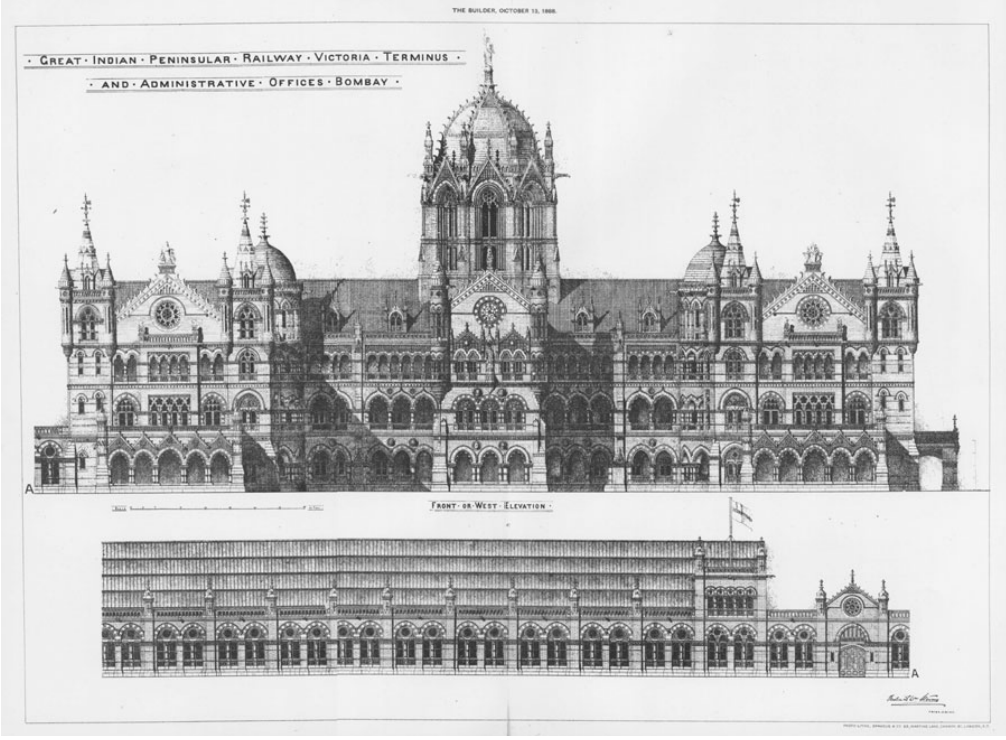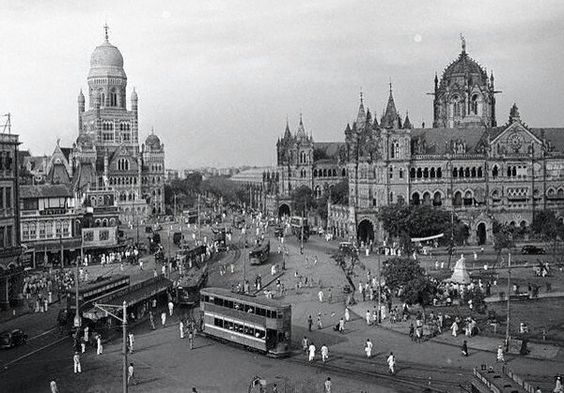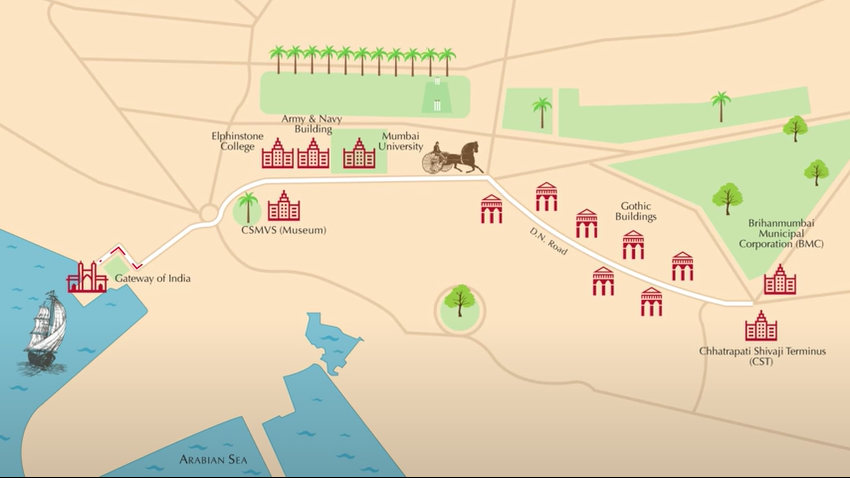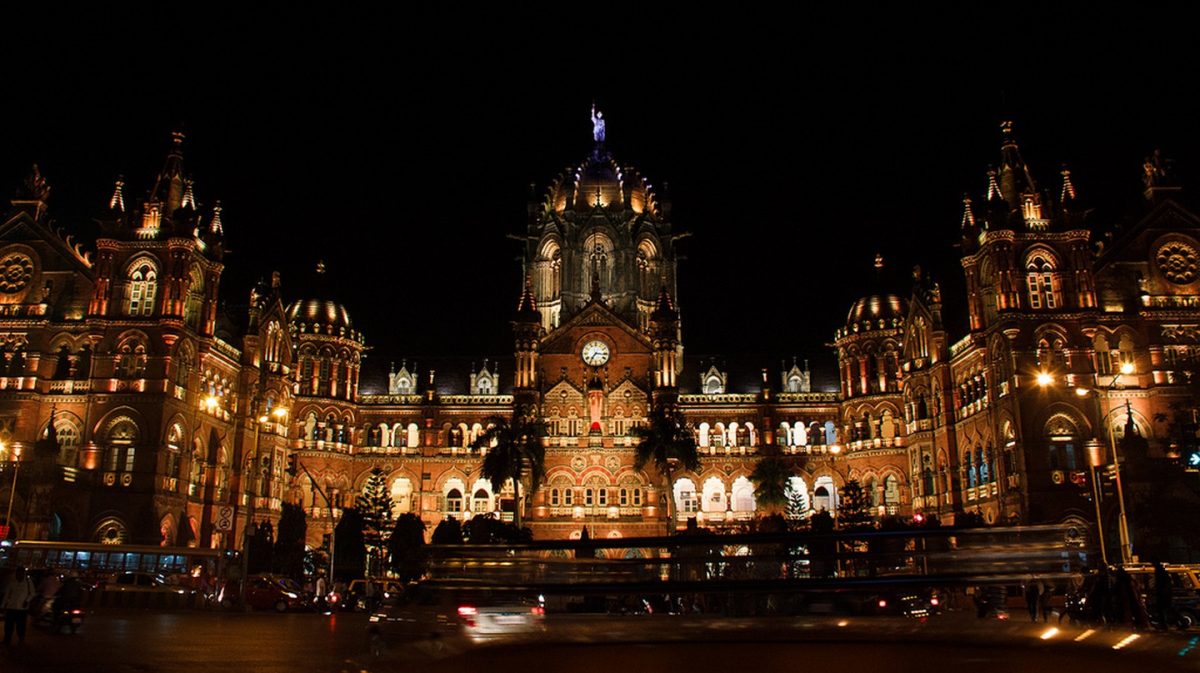
The architecture of India has evolved throughout centuries, deeply rooted within history, culture, traditions, and religion. The British legacy in India remains among the infrastructure of the nation as colonial buildings in India use their architecture as expressions of control and power. The Chhatrapati Shivaji Terminus, formally known as the Victoria Terminus in Bombay is one that exhibits such histories of control along with the influence of colonial relationships. Through the analysis of architectural styles and the juxtapositions of colonial and Indian cultures, the architecture of the Chhatrapati Shivaji Terminus exhibits India’s colonial history along with the narrative that both the colonial regime along the native communities create a new identity for the city during the British Raj.
John Begg (1866–1937), the consulting architect to the government of India from 1908 to 1921 elaborates on the idea of two schools of architecture built to define India. The “ Roman School” using the Romans as their model and force British architecture as well as British ideologies of justice, law, and order to further improve and reflect themselves on to the empire, and the “Swadeshi School” which maintains the Indian traditions and allows for the existing architecture to be nourished and sustained.1 However, the architectural style of the government building in the city of Bombay displayed a combination of both schools of architecture, developing a style that represented a synthesis of local traditions with European forms.
Although the Gothic Revival architectural style more prominently defined Bombay, rather than the Indo-Saracenic architectural style that was expanding throughout the nation. Bombay’s Gothic Revival architecture still represented the partnership between the colonial and native communities.2 The Chhatrapati Shivaji Terminus, formally known as the Victoria Terminus depicts such ideologies of the fusion between architectural styles. Named after the reigning Empress of India: Queen Victoria, The Victoria Terminus was built over a period of ten years during the height of imperialism in the nation, from 1878-1888 in Mumbai (formerly known as Bombay), Maharashtra, India.3 With the intentions to transform the city, the governor of Bombay, Sir Henry Bartel Endward Frere planned to give the city a new status as a “modern city”; through the Victorian Gothic architecture and “enhance the government’s image, and enable it to expand its services and rule more effectively”.4 The railway station was built as the headquarters of the Great Indian Peninsular Railways and to replace the Bori Bunder railway station to meet the increasing demands of the cities imports and exports. The location of the Terminus was placed strategically, determined by the availability of large property along with a prominent central location within the city. The building faced Bombay’s official government buildings to its West, with the docks and the harbor situated behind it and the Crawford Market and residential neighborhoods to its South.5 The central location of the station facilitated both trades of goods from the steamships to the railways along with the movement of the British soldiers to various parts of the subcontinent.


Used as part of the “Gateway to India”, the Victoria Terminus was part of a border agenda that took place throughout the city of Bombay, to not only display the British reign of power but also to create a new image of the city. Through a narrative to impress the incoming British troops as Bombay was the landing point, and ceremonially going down a specific route starting from the Gateway of India, down through Dadabhai Naoroji Road (D.N.Road) deliberately passing through various Victorian Gothic buildings such as the CSMVS Museum, Elphinstone College, Army and Navy Building, Mumbai University, Flora Fountain and finally arriving at the civic plaza with two prominent buildings, the Bombay Municipal Corporation and the Victoria Terminus. The intentional narrative created through the procession and the architecture further created a sense of purpose to fight for the empire.6

Designed by Frederick William Stevens, an English architectural engineer and a team of Indian craftsmen. The Terminus exhibits the integration of influences from Victorian Italianate Gothic Revival architecture and Indian Traditional buildings, as “This style was acceptable to both European and Indian taste since it was compatible in its use of colour and ornamentation with the Mughal and Hindu architecture of the subcontinent. The skyline, turrets, pointed arches, and eccentric ground plan is close to traditional Indian palace architecture”.7 Further providing the city of Mumbai with a new identity as “The Gothic City” and as a major mercantile port city on the Indian subcontinent within the British Commonwealth. The fusion between High Victorian Gothic and Classical Indian architectural styles further emphasizes the narrative of the cities identity rooted within colonialism and the reflection of gothic architecture seen as a progressive joint partnership within a new public arena they created.8 Originally inspired by the Scott’s St. Pancras Station in London, however, through the collaboration of various parties during its construction. The terminus created an identity of its own, through the massive masonry dome, rich Italian Gothic detailing in polychromatic stone along with decorative tile, marble, stained glass, and sculptures created by the native craftsmen from the Sir J.J School of Arts expressing a mixture of the local cultures. The Vicotria Terminus, through Gothic architecture, symbolized the “supremacy and majesty of Britannia “ruling the waves” and even more importantly, the technological triumph of the Empire — the introduction of the railway to India”.9 Although further instilling a sense of permanency for the British empire within India, the partnership between the colonizer and the colonized creates a unique narrative as various parts of each tradition construct a dialogue of its own through architecture in the built environment. As the native community aided in adapting to make concessions to the cities environment and construction with local materials; to meet climate conditions such as the extreme heat and monsoon rains of Bombay with the inclusion of verandahs, central courtyards, and double corridors for ventilation and sheltered spaces from direct heat.10 Through sculptures, capitals, and friezes, the local craftsmen within the colonial empire assert their industry; through ornamentation and decoration of tympanums and spandrels with beautifully carved floral designs, local fruits, indigenous birds, and mammals. The incorporation of Indian sculptures made by Indian sculptors creates a link to the community, further establishing an identity within the “Modern City”.


The architectural style of Bombay’s Gothic Revival came to symbolize the city. Representing colonialism and the dynamic relationships that fostered through architecture. The Chhatrapati Shivaji Terminus, although rooted in colonialism, through the incorporation of the local communities and desire to progress and adapt to the built environment has created a new meaning and identity of the station, embedded in the history of India through Victorian Gothic architecture; becoming prominent symbols of the city of Bombay.
Footnotes:
(1) Chopra, Preeti. A Joint Enterprise: Indian Elites and the Making of British Bombay. Minneapolis: University of Minnesota Press, 2011: 31.
(2) Chopra, Preeti. A Joint Enterprise: Indian Elites and the Making of British Bombay. Minneapolis: University of Minnesota Press, 2011: 72.
(3) Jiwani, Subuhi. “Chhatrapati Shivaji Terminus: India’s Grandest Railway Station.” Sahapedia, July 18, 2018.
(4) Jiwani, Subuhi. “Chhatrapati Shivaji Terminus: India’s Grandest Railway Station.” Sahapedia, July 18, 2018.
(5) Jiwani, Subuhi. “Chhatrapati Shivaji Terminus: India’s Grandest Railway Station.” Sahapedia, July 18, 2018
(6) Jiwani, Subuhi. “Rahul Mehrotra on CST.” Sahapedia, July 18, 2018.
(7) Centre, UNESCO World Heritage. “Chhatrapati Shivaji Terminus (Formerly Victoria Terminus).” UNESCO World Heritage Centre, 2004.
(8) Chopra, Preeti. A Joint Enterprise: Indian Elites and the Making of British Bombay. Minneapolis: University of Minnesota Press, 2011: 33
(9) Jiwani, Subuhi. “Chhatrapati Shivaji Terminus: India’s Grandest Railway Station.” Sahapedia, July 18, 2018
(10) Metcalf, Thomas R. An imperial vision: Indian architecture and Britain’s Raj. Berkeley: University of California Press, 1989: 443.
Bibliography:
Centre, UNESCO World Heritage. “Chhatrapati Shivaji Terminus (Formerly Victoria Terminus).” UNESCO World Heritage Centre, 2004.
Chopra, Preeti. A Joint Enterprise: Indian Elites and the Making of British Bombay. Minneapolis: University of Minnesota Press
Jiwani, Subuhi. “Chhatrapati Shivaji Terminus: India’s Grandest Railway Station.” Sahapedia, July 18, 2018
Jiwani, Subuhi. “Rahul Mehrotra on CST.” Sahapedia, July 18, 2018.
Metcalf, Thomas R. An imperial vision: Indian architecture and Britain’s Raj. Berkeley: University of California Press, 1989.
